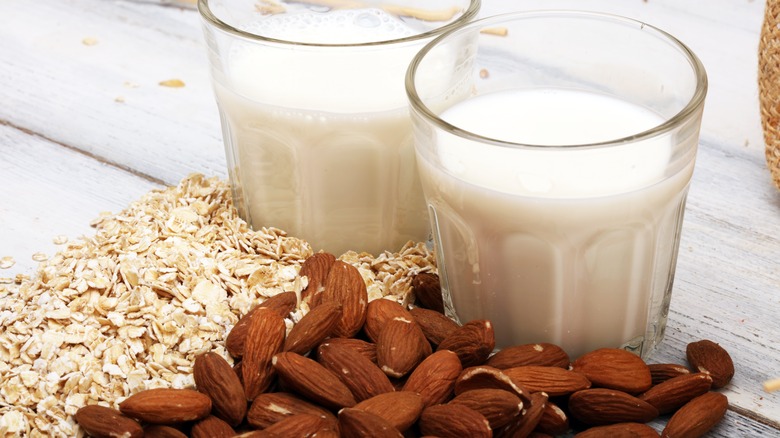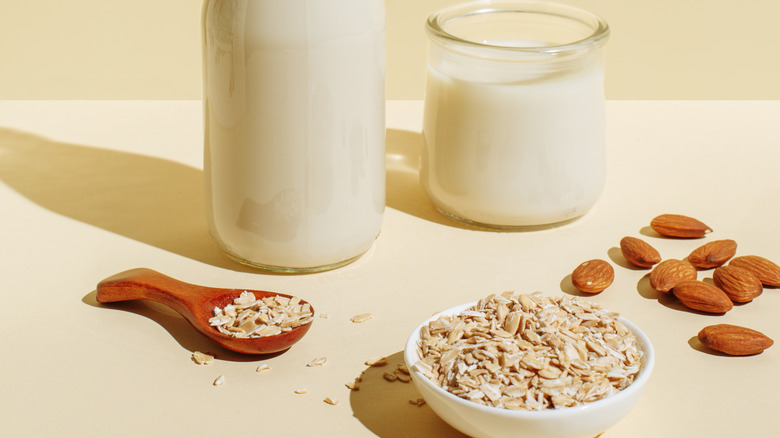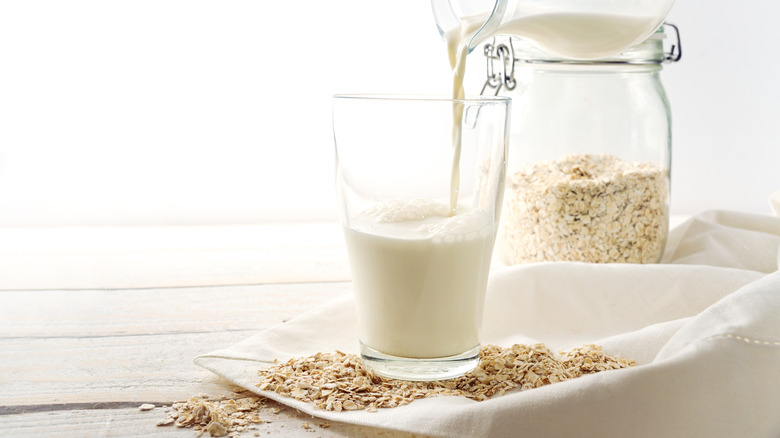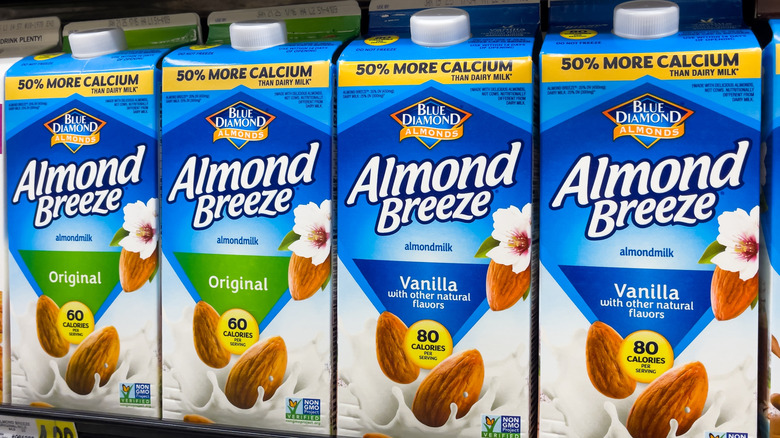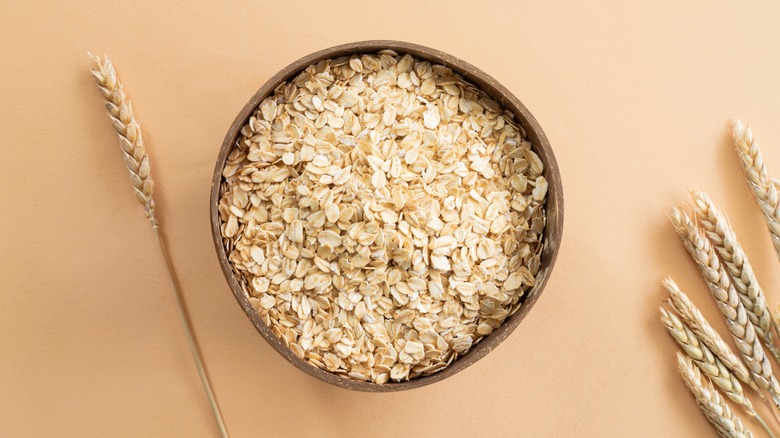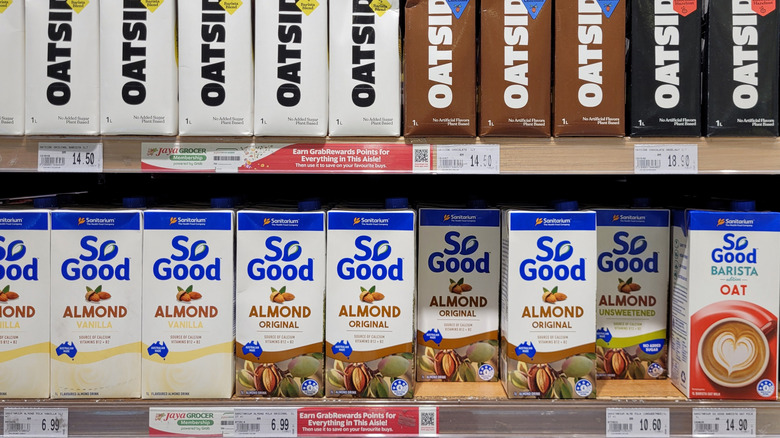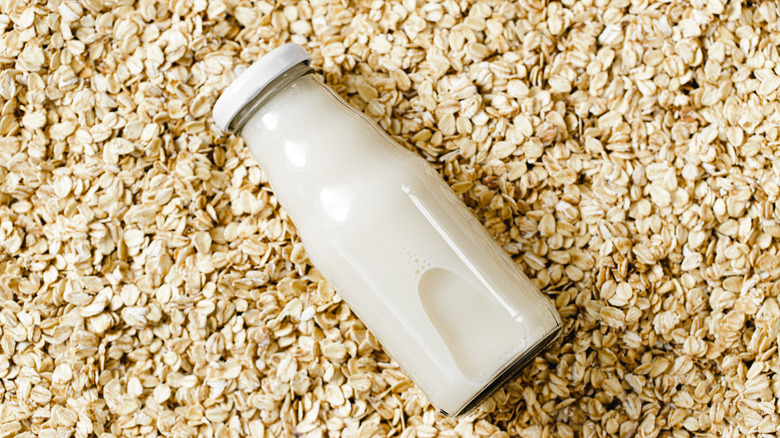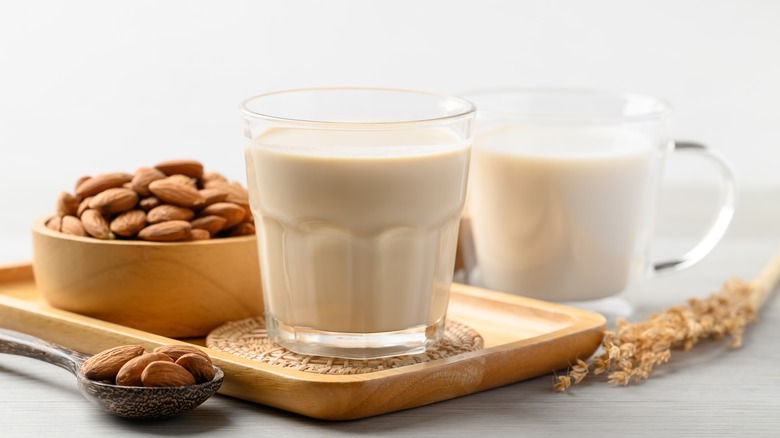Oat Milk Vs Almond Milk: What's The Difference And Is One Better For You Than The Other?
Dairy-free and plant-based milks seem to be all the rage lately. Globally and domestically, alternative milk purchases are on the rise. Be you looking to avoid lactose, choose a more sustainable milk, or are just feeling a little vegan-curious, plant-based milks are a wonderful option worth looking into. When it comes to milk alternatives, almond milk and oat milk stand as two of the most popular. Almond milk continues to dominate the plant-based milk scene, but oat milk has been quickly gaining popularity as a close second.
People are turning to plant-based milks for a variety of motives citing both environmental and health reasons, yet the vast majority simply like the taste. Despite your basis for deciding to add non-dairy milk to your diet, almond milk and oat milk remain exceptional choices. Both are dairy-free and lactose-free, vegan-friendly, more sustainable than cow's milk, and, most important of all, have a pleasant taste. But how do they differ? The distinctions are many, varying in terms of consistency, taste, nutritional makeup, and more. When it comes to health, however, the answer is somewhat more complicated.
What is oat milk?
Oat milk is a dairy alternative derived from oats and water. Relatively new to the plant-based dairy scene, oat milk was first created in the 1990s by Rickard Öste, a food scientist based in Sweden who was researching lactose intolerance. As oats were an abundant crop in his homeland, he decided to transform them into a dairy-free alternative that would resemble cow's milk. The end product was Oatly, the very first commercially sold oat milk. However, it wouldn't be until 20 years later that oat milk caught on in the U.S. In the past decade, the popularity of oat milk has risen tremendously.
The exact process of making oat milk varies by each company, but fundamentally the overall steps are the same. Commercially, oat milk is made by first milling oats into a fine oat flour that is blended with enzymes and water. This base is cooked, given an enzymatic treatment, separated, and homogenized to improve its texture. Sometimes, additional ingredients like flavoring, calcium, and vitamins are also added. Finally, this plant milk faces ultra-high temperature treatment to destroy bacteria.
What is almond milk?
Almond milk is another plant-based dairy alternative that is, surprisingly, much older. References to almond milk have been seen in texts stretching back to the medieval period, particularly in the 8th to 12th centuries where it was once thought to alleviate breathing conditions. In the 13th and 14th centuries, references to almond milk show up in recipes, specifically in regions where almonds were heavily admired, like Egypt. Eventually, almond milk spread to European communities where it gained popularity during Lent amongst Christians abstaining from cow's milk. Today, almond milk remains the most popular plant-based milk in the U.S. accounting for 56% of sales in the United States, per Evident.
At its core, almond milk is made up mostly of water and almonds. In commercial production, it is made from almonds that are blanched and peeled, ground, and added to water along with some other additives. Some of these additional components include sunflower, almond, or canola oil to improve texture, vitamins, and occasionally, the addition of sugar or vanilla for flavoring.
Almond milk is nuttier, while oat milk is sweeter
How do oat milk and almond milk compare taste-wise? Oat milk is often described as sweeter than almond milk, as more sugar results from processing the oats. This is partially due to a specific type of sugar in oat milk, known as maltose. When oat milk is being made, enzymes are added to help break down the oat starches, consequently sweetening the product naturally in the process. By contrast, almond milk possesses a slight nuttiness in terms of flavor. It lacks the natural sweetness of oat milk due to the lack of starch, but flavored varieties can remedy this.
As a result, those sensitive to sweet flavors may inherently prefer almond milk, while those who dislike a nutty taste may prefer oat milk. Both almond milk and oat milk contain flavored varieties including unsweetened versions or those complemented with a touch of vanilla or chocolate. Some experimenting may be required to find your perfect match.
Oat milk is naturally creamier
When it comes to texture, oat milk often boasts a thicker consistency and appears more opaque, while almond milk can be more watery. Many agree that oat milk bears a closer resemblance to cow's milk than almond milk does and best echoes its consistency. On occasion, additives like carrageenan are added to almond milk to thicken and enrich its texture. Although safe to consume in modest quantities, large amounts of carrageenan may cause gastrointestinal distress, potentially affecting digestive health and prompting gut inflammation.
Due to its naturally thicker consistency, oat milk has no need for such additives. Despite this, some brands of oat milk offer "barista" or "extra creamy" versions for lovers of that ultra-thick texture. Great for frothing, these creamier varieties often include more oil for added creaminess, usually including either rapeseed oil or sunflower oil. These differences in consistency are most apparent when drinking either milk on its own. Still, if you're simply looking for a plant-based milk to add to cereal or stir into a morning cup of joe, texture may not be of the utmost importance to you.
Almond milk is better for keto or paleo diets
Nutritionally, almond milk contains more calcium and is higher in fat, although oat milk outpaces almond milk in iron and carbohydrates. This makes almond milk better for keto diets that avoid carbs and paleo diets that avoid grains. If protein is of particular concern to you, you may be surprised to learn that oat milk carries more protein than almond milk. The reason behind this is largely due to the process by which oat milk is made. Both almonds and oats are soaked in water before blending, but this technique draws more nutrients out from the oats than it does from almonds.
When it comes to caloric content, oat milk is generally higher. Extra creamy and barista varieties of oat milk will be some of the highest in terms of calories due to the added oils, while plain varieties will be lower. Although calories can depend on the brand, generally almond milk tends to be the lowest of all plant-based milks in terms of calories.
Flavored and fortified varieties are more complicated when it comes to nutrition
Sweetened and flavored varieties of almond milk and oat milk will normally contain more calories and sugar than unsweetened varieties. For example, Oatly's chilled Super Basic Oatmilk holds 80 calories and 7 grams of sugar per serving. By contrast, its Chilled Chocolate Oatmilk harbors 150 calories and 16 grams of sugar per serving. Likewise, Silk's Vanilla Almondmilk contains 80 calories and 13 grams of sugar per cup, while its Unsweet Almondmilk has 30 calories and 0 grams of sugar per cup.
Many plant-based milks will be fortified to add in nutrients that are present in cow's milk, but missing in plant-based milks. For this reason, fortified almond milk can actually contain more calcium than cow's milk. Fortified and unfortified varieties also differ in terms of nutritional content. Unfortified oat milk has a lower fat content than almond milk or cow's milk, but more carbohydrates and fiber. It also contains more protein than almond milk, although not nearly as much as cow's milk. Fortified versions of both types often contain added calcium and additions like vitamin A, vitamin D, and vitamin B12 to better mimic the nutritional content of cow's milk.
Oat milk is nut-free, but iffy for gluten
It goes without saying that anyone with a nut allergy should opt for oat milk over almond milk, but what about other allergens? Although most plant-based milks are gluten-free for the most part, oat milk may not be the best choice for those with severe gluten intolerances. This is because oats suffer from more cross-contamination with wheat products. Although oats are gluten-free by nature, they are frequently grown in close proximity to wheat and often processed in places that simultaneously process wheat. This can result in unintentional cross-contamination, which is dangerous for certain conditions like celiac disease.
Almond milk has less of a chance of cross-contamination with gluten and is generally more likely to be labeled as gluten-free, although one must pay close attention to any additives in flavored almond milk that can potentially contain gluten. Those who strictly cannot consume gluten should purchase plant milk products that are certified as gluten-free. This is the only way to be entirely sure that your milk is gluten-free.
Almond milk is less expensive
Although plant milks generally weigh in at double the price of regular cow's milk, oat milk tends to be more expensive than almond milk. As reported by Columbia Climate School in 2021, almond milk goes for about $4 per ½ gallon, while oat milk tends to be one of the more expensive of all plant-based milks at $5 per ½ gallon. This cost difference is surprising to many considering the price of almonds, but almond milk likely contains far fewer almonds than many people think. A 2015 lawsuit that was later settled alleged one brand of almond milk, Almond Breeze by Blue Diamond, actually contained only2% almonds. This partially might explain the price difference.
If you're curious why plant-based milks remain at a cost so much higher than cow's milk, it's largely due to the process involved in making them. Dairy milk requires some attention after it leaves the cow, but not nearly as much processing as almonds, oats, or soybeans. Additionally, plant-based milk comes with more costs for marketing, bottling, and packaging. Even with oat milk's increasing popularity, prices are unlikely to come down anytime soon. With the combined effects of inflation, increasing demand, larger costs to production, and even the war in Ukraine that has affected grain supplies and grain prices, oat milk's price will likely continue to increase.
Oat milk is more sustainable
To those wondering which plant-based milk is most sustainable, the answer is usually oat milk. Compared to cow's milk, almond milk is still a better choice when it comes to sustainability, having far less land use and greenhouse gas emissions than cow's milk. However, almond milk's greatest weakness is its freshwater use, with just one California almond averaging 3.2 gallons of water to produce. When we measure oat milk against almond milk, oat milk may be slightly more environmentally-friendly. Oat milk has a lower carbon footprint than almond milk does, and it requires less water to produce than almond, rice, and dairy milks. Its land use may be higher than almond milk as well as greenhouse gas emissions, but it uses about 14% the amount of fresh water.
Still, any plant-based milk at all is better for the environment than cow's milk. Dairy milk results in two to three times the amount of greenhouse gas emissions and takes up about 10 times the amount of land. Subsequently, either almond milk or oat milk are a better choice for the environment.
You can make both at home, but almond milk will take longer
If you are wary of preservatives and unnecessary additives, almond milk and oat milk can both be made at home. To make almond milk, you must first soak the almonds in water overnight. About 12 hours is good, but you can also soak them longer (up to two days) for a creamier result. Next, drain them and blend with fresh water and a sprinkle of salt using a ratio of 1 part almonds to 3 parts water. Strain the pulp through a nut milk bag or cheesecloth to extract the liquid and discard the pulp. Lastly, clean your blender and pour the liquid back in. Add any final flavorings like sweeteners or spices at this point and give the almond milk a final blend to incorporate. As mentioned in our homemade almond milk recipe, you can increase or decrease the water to your liking to create a thinner or thicker milk.
The process for oat milk is similar and can be made from rolled oats that require no overnight soaking. Simply blend rolled oats with water, salt, and any flavorings desired, then gently strain through cheesecloth and discard the oat pulp. Do not over squeeze the pulp or you will end up releasing more starch, given the milk a slimy texture. Taste and add more flavoring if desired. For extra smooth oat milk, strain the mixture twice, then refrigerate and use as desired. You can also use toasted cracked oats to make your own homemade oat milk, but these will require a longer soaking period. Just know that you can't make oat milk from instant oats. The result will be slimy and gummy.
Almond milk is better for cereal, smoothies, and savory dishes
Certain plant-based milks are better suited to specific dishes. Seeing as almond milk carries a soft, nutty flavor, it pairs better with savory recipes. Vegan pasta sauces or dairy-free mashed potatoes benefit from using unsweetened almond milk in lieu of cow's milk. Due to almond milk's thinner consistency, many also prefer it in cereal. Almond milk is also exceptional for adding to blended drinks like a breakfast smoothie or refreshing green grape smoothie.
Looking for a more indulgent treat? Consider wielding chocolate almond milk and blending it with frozen bananas to whip up a chilled vegan delight. Yet fruit-filled smoothies aren't the only drink in which almond milk can be employed. Fashion a non-dairy white Russian or try an almond milk mudslide. It can also be used anywhere where its nutty flavor might complement the flavor profile of a dish well, like our vegan pumpkin pecan rice pudding.
Oat milk is better for frothing, creamy sauces, and baked goods
Oat milk's signature creaminess and thicker texture makes it more ideal for frothing in cappuccinos and lattes, especially the thicker varieties made for these purposes. In fact, oat milk is one of the best, if not the best, non-dairy milk for frothing. Oat milk can also make a lovely vegan hot chocolate due to its thicker, more milk-like texture. As oat milk is naturally a bit sweeter than almond milk, it also makes it better for baking.
Consider harnessing oat milk for muffins or brownies. Still, oat milk is not without its more savory uses. Its similar texture to cow's milk also renders it preferable for crafting creamy sauces. Oat milk can even be utilized to make a vegan béchamel sauce for pasta and more. Just be sure to use unsweetened varieties for savory recipes.
Which is healthier hinges on individual circumstances
Whether almond milk or oat milk is better for a single person depends on their goals and individual health conditions. Oat milk is the sounder choice for those with nut allergies, however, it may need to be avoided by those with severe gluten intolerances due to its likelihood for gluten contamination. Conversely, almond milk may be better for those who are diabetic due to the higher carbohydrate makeup of oat milk. Almond milk is also a more fitting option for those on low-carb diets like keto or for paleo diets that steer clear of grains. Regardless of whether you opt for almond milk or oat milk, fortified versions will have more added nutrients.
Unsweetened varieties are also recommended for those looking to curb their sugar consumption. Additionally, oat milk is slightly better for the health of the planet, so it might be the winning draw for those who prefer sustainable, eco-conscious choices.

